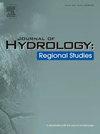巴西塞拉多生物群落在土地覆盖变化和气候变率双重威胁下的水通量评估
IF 5
2区 地球科学
Q1 WATER RESOURCES
引用次数: 0
摘要
研究区域巴西塞拉多森林生物群落是热带稀树草原,其中超过50% %已被转化为农业用地。研究重点我们评估了气候变化导致的水平衡变量(地表通量、蒸发、土壤水分储存、入渗、地下水补给和根系吸收)的变化。该研究包括:(1)通过对甘蔗和牧草覆盖试验区与天然林的6年土壤湿度观测,对Hydrus模型进行校准和验证;(2)将Hydrus模型与气候模型(SSP2-4.5和SSP5-8.5情景下的10个CMIP6模型)的预估相结合,进行水文预测。我们在标定过程中测试了不同的参数组合,发现对于甘蔗和牧草,土壤饱和含水量、土壤保持函数参数N和饱和导水率是对标定最敏感的参数。经验证的模型性能良好,质量平衡误差小于0.9 %。结果表明,气候变化对某些水通量的影响大于对其他水通量的影响,其影响顺序依次为:土壤-水储量、底部通量、入渗、地表通量、蒸发和根系吸收。例如,到2100年底,甘蔗和牧草作物的根系吸收量预计将增加26% %,从而给区域用水需求带来压力。最后,土地覆盖变化目前对水通量构成的风险比预估的气候变化更大。本文章由计算机程序翻译,如有差异,请以英文原文为准。
Assessment of water fluxes under the dual threat of changes in land cover and climate variability in the Brazilian Cerrado biome
Study region
The Brazilian wooded Cerrado biome is a tropical savanna, over 50 % of which has been converted to agricultural land.
Study focus
We evaluated changes in water balance variables (surface flux, evaporation, soil-water storage, infiltration, groundwater recharge, and root uptake) due to climate change. The study included (i) calibration and validation of the Hydrus model through observations of soil moisture in experimental plots covered with sugarcane and pasture compared to natural forest during six years and (ii) hydrological predictions by combining Hydrus with projections from climate models (10 CMIP6 models under SSP2–4.5 and SSP5–8.5 scenarios).
New hydrological insights for the region
We tested different parameter combinations during calibration and found that for sugarcane and pasture, saturated soil water content, parameter N in the soil retention function, and saturated hydraulic conductivity were the most sensitive ones to improve calibration. The validated models demonstrated good performance, with a mass balance error of less than 0.9 %. The results indicate that climate change will affect certain water fluxes more than others, in a hierarchical (bottom-top) sequence: soil-water storage, bottom flux, infiltration, surface flux, evaporation, and root uptake. For example, root uptake is expected to increase by 26 % in sugarcane and pasture crops at the end of 2100, pressuring water regional demand. Lastly, land cover change currently poses a greater risk to water fluxes than projected climate change.
求助全文
通过发布文献求助,成功后即可免费获取论文全文。
去求助
来源期刊

Journal of Hydrology-Regional Studies
Earth and Planetary Sciences-Earth and Planetary Sciences (miscellaneous)
CiteScore
6.70
自引率
8.50%
发文量
284
审稿时长
60 days
期刊介绍:
Journal of Hydrology: Regional Studies publishes original research papers enhancing the science of hydrology and aiming at region-specific problems, past and future conditions, analysis, review and solutions. The journal particularly welcomes research papers that deliver new insights into region-specific hydrological processes and responses to changing conditions, as well as contributions that incorporate interdisciplinarity and translational science.
 求助内容:
求助内容: 应助结果提醒方式:
应助结果提醒方式:


